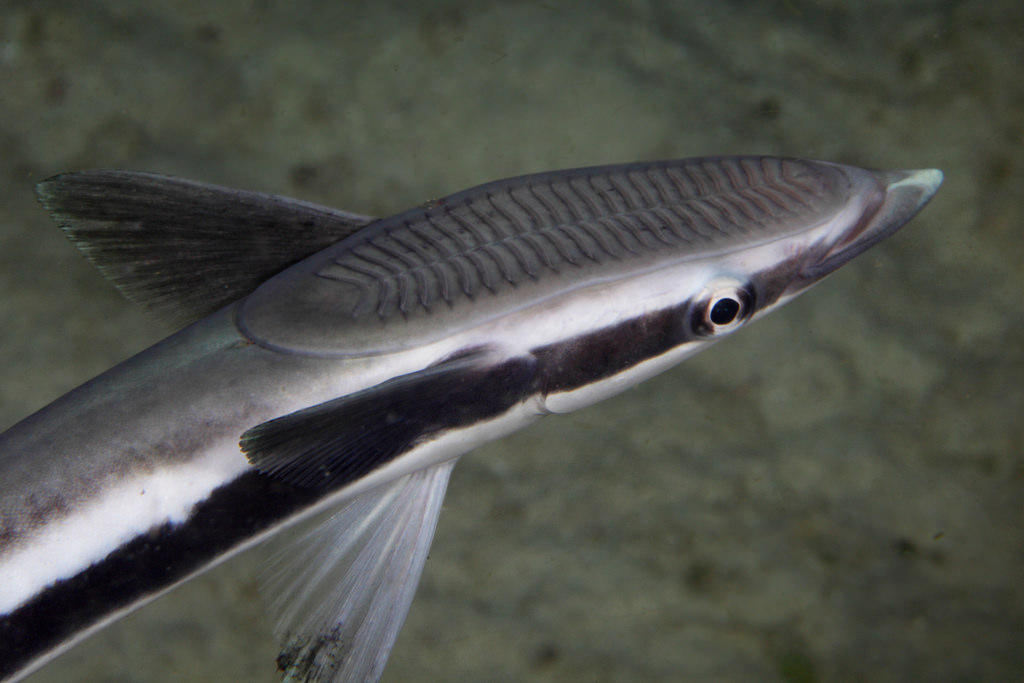With 30,000 species of fish identified and catalogued, you’d think some of the more exotic might belong in our growing business bestiary. You’d be right. For example:
Remoras
Remoras have a suction cup on top of their heads. But they aren’t parasites. Just freeloaders. With the suction cup they attach themselves to a convenient predator — sharks are the best-known, but hardly the only ones.
| Photo by Klaus Stiefel – all rights reserved |
Remoras benefit twice from this arrangement: They get a free ride, and the free ride reliably takes them to a source of food: When sharks kill prey they aren’t tidy. They leave little bits of meat floating around, which the Remora is happy to snag.
The Remoras you have to deal with are like this. Neither energetic nor particularly competent, they ride along on team activities. They don’t produce much, but they don’t get in the way, either. Their specialty is being harmless. In return they get a share of credit for their team’s success.
The problem is that their teammates have to pick up the slack. If you’re part of a seven-person team with one Remora, the rest of you either have to work 15% harder, or you have to accept that your team will be about that much less productive than any non-Remora-afflicted teams you’re compared to.
What to do when a Remora suctions onto you?
What managers can (and can’t) do
Managers can do their best, assigning tasks, making sure “completion” has a tangible definition, and reviewing at least a sample of task results to make sure everyone is at least getting something identifiable done.
But this won’t tell you whether one is a Remora who relies too much on help from teammates, especially because you want to encourage team members to ask each other for help when they’re stuck. Beyond this you also want to assign some tasks as collaborations.
Also, leaders are responsible for team dynamics, and you don’t want a team where ratting each other out to the manager is a common solution, nor do you want to fall into the trap of adjudicating these disputes.
So in the end, Remoras are a team problem. As a team member, what can you do? You can:
- Complain to your manager, who is, after all, supposed to make sure all members of the workforce are productive.
But in addition to the ratting-out issue, there’s a good chance your manager already knows about the Remora, but isn’t willing to deal with the problem because (1) documenting the Remora’s poor performance in ways HR will accept isn’t always as easy as it sounds; and (2) the Remora is an inoffensive soul and the manager doesn’t want the guilt associated with terminating someone who isn’t, in the end, a bad human being.
- Accept some of the extra workload, leaving the rest to marginally poorer team performance, and don’t worry about it.
There’s a lot to be said for doing nothing. It’s a stress-free alternative. Here’s how to decide whether it’s the right choice: Make a list of the five biggest problems you face every day in doing your job. If the Remora doesn’t make the list, it’s time to shrug your shoulders and get on with it.
- Help the Remora find something productive to do. Many Remoras aren’t what they are by choice. They just aren’t very good at what they’re supposed to do and don’t have much opportunity to do what they are at least semi-competent to take on.
Figure out some tasks they can do that would help out the team, and enlist friends on your team to figure out some more. There’s almost always something, even if it’s just taking and publishing all meeting notes, manually unit-testing user-interface code other team members produce, or taking care of bits and pieces of paperwork that’s even more annoying than having a Remora on the team.
- Ignore. Just because someone asks you for help, that doesn’t mean you have to provide it. As the old saying goes, fool me once, shame on you. Fool me thirty-seven times, shame on me.
Something to keep in mind as you decide what to do about your workplace Remoras:
Sharks ignore them.
* * *
Thanks to Ed Paquette, Paul Schaefer, and Myron Ware for suggesting and offering their descriptions of this gilly critter.

